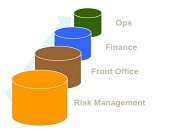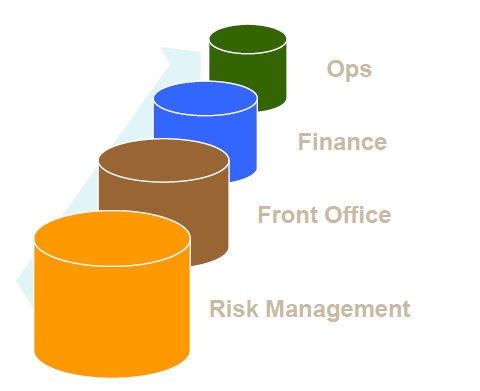“Financial regulators have introduced stress testing as a means to cut across silos,” said Dan Travers, VP of Product Management, Adaptiv at SunGard and the opening speaker at a GARP webinar on May 21, 2013. Historically, he noted, financial risk has been treated as a set of separate units (or silos) across the main types of risk: credit, market, operational, and liquidity risk, the latter connected to asset-liability management (ALM).
The new reporting demands of Basel III and Dodd-Frank serve to break down silos, Travers said, with such things as incremental risk charge being reported as capital percentage for the firm as a whole. Another example is that credit valuation adjustment (CVA) turns credit into market risk. Travers said a recent survey showed only one of out three financial institutions has a common reporting platform, no matter the source of the risk. “Liquidity analysis is putting pressure on banks to look at all risk types together,” he said. “Consistency is a major challenge.”
Risk management is not just partitioned in silos according to risk types; Travers pointed out there are also silos across business functions. Due to the financial crisis, risk now has a higher profile across the institution, and senior management have become more aware of capital ratios. “If certain business lines are capital intensive, there’s an incentive to reduce capital demand,” he said.
New regulations are breaking down the silos across business function. Travers cited the example of collateral, which used to be simply an operations function. “Now it’s part of counterparty risk under Basel III.”
“Collateral optimization is mixed in with trading,” said Travers. He called on finance departments to drill deeper into risk numbers, and cautioned that one requirement for front office to use risk numbers is that they “need to be available in real time.”
In response to a question from the audience on the future of global banking, given the complexity of regulations, Travers agreed that regulations are onerous. “Internal arbitrage and overlap—where stress testing must be repeated under different regimes—makes profitability problematic.” He characterized the environment of low interest rates and low margins as “challenging.”
After sketching out the existence of silos—by risk type and by line of business—and the need to report enterprise-wide risk measures, Travers acted as moderator and posed questions about the breakdown of silos to the next two panellists. ª
The webinar presentation slides can be found at: http://event.on24.com/r.htm?e=614560&s=1&k=D493202F85CBF2098C216D611906019B>


